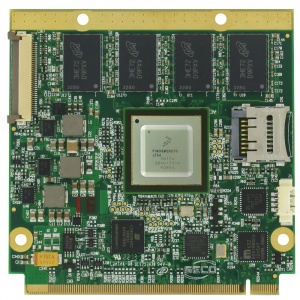Summary of Seco’s New i.MX8M And i.MX8Quad Based Modules Run Linux
Seco Embedded Creators released the Q7-C25 and Q7-C26 modules, based on NXP’s i.MX8M and i.MX8Quad processors, respectively. Both run Linux and Android, available in industrial temperature ranges. The Q7-C25 offers up to quad-core Cortex-A53 at 1.5GHz with 4GB LPDDR4 RAM, while the Q7-C26 features a more powerful hexacore i.MX8Quad with SATA III support. Both support 4K60 HDR video via HDMI 2.0A, with additional DisplayPort on the Q7-C26. Connectivity includes multiple USB ports, PCIe, GbE, and various I/O interfaces, targeting applications demanding flexible, high-performance embedded computing.
Parts used in the Q7-C25 and Q7-C26:
- NXP i.MX8M Cortex-A53 processor (dual or quad-core) – Q7-C25
- NXP i.MX8Quad (quad to hexacore Cortex-A53/A72) processor – Q7-C26
- 266MHz Cortex-M4 MCU(s)
- Vivante GC7000Lite GPU(s)
- LPDDR4-3200 RAM (up to 4GB on Q7-C25)
- Optional onboard eMMC flash
- Optional onboard QSPI flash
- HDMI 2.0A port
- DisplayPort 1.3 (Q7-C26 only)
- LVDS interface
- MIPI-CSI camera interface
- I2S audio interface
- USB ports (5 on Q7-C25, 6 on Q7-C26)
- USB 3.0 ports (2 on Q7-C25, 1 on Q7-C26)
- USB OTG port (Q7-C26 only)
- PCIe x1 interfaces (2x on both, one replaceable by SATA III on Q7-C26)
- SATA III interface (factory option on Q7-C26)
- Gigabit Ethernet controller
- 2x I2C interfaces
- 8x GPIO
- UART interface
- CAN interface
- SPI interface
- SD card interface
- Watchdog and power management signals
- Boot select signal (Q7-C26 only)
Seco Embedded Creators have launched the i.MX8M based Q7-C25 and i.MX8Quad based Q7-C26. Both can run Linux and Android, and are available in 0 to 60°C and -40 to 85°C models. The 5V modules have many similar features, but the Q7-C26 based on the more powerful, up to hexacore i.MX8Quad adds some extras such as SATA III support.
The Q7-C25 utilizes NXP’s dual- or quadcore, 1.5GHz Cortex-A53 i.MX8M. It facilitates a 266MHz Cortex-M4 MCU and a Vivante GC7000Lite GPU. Unlike the Quad and Dual models, the quad-core i.MX8M QuadLite model lacks a VPU.
On the other hand, the Q7-C26 features the more powerful i.MX8Quad, which is available in quad A53 configurations, but clocked to a lower 1.26GHz. All three i.MX8Quad Quad models also accommodate dual Cortex-M4 MCUs and dual GC7000Lite GPUs. The mid-range i.MX8QuadPlus model combines 1x Cortex-A72 core and the high-end QuadMax adds 2x -A72 cores.
Both the Q7-C25 and Q7-C26 ship with onboard LPDDR4-3200 RAM, but only the Q7-C25 lists a quantity, which is up to 4GB. They both offer presumably optional eMMC and QSPI flash onboard, but no quantities are listed. Only the Q7-C26 supports SATA III, but it’s a factory option swap-out for one of the 2x PCIe x1 interfaces provided by both modules. Both COMs also combine a GbE controller.
Both the Q7-C25 and Q7-C26 support up to 4096 x 2160p60 video output with HDR via an HDMI 2.0A port. On the Q7-C26 DisplayPort 1.3 is supported, and the Q7-C26 also supports HDCP 2.2. Both modules also provide an HD-ready LVDS interface, I2S audio, and a MIPI-CSI camera interface.
The Q7-C25 supports 5x USB ports compared to 6x on the Q7-C26. Yet on the Q7-C25, two of those are USB 3.0 compared to one on the Q7-C26, which is the only one to support a USB OTG port. Common features on both modules are 2x I2C, 8x GPIO, and single UART, CAN, SPI, and SD connections. They both supply a watchdog and power management signals and the Q7-C26 also features a boot select signal.
Read more: Seco’s New i.MX8M And i.MX8Quad Based Modules Run Linux

